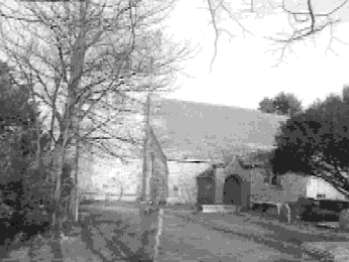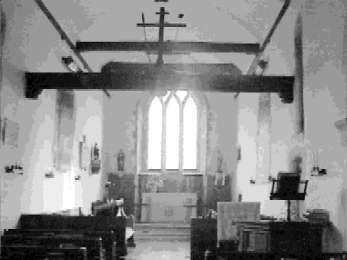![]()

![]()
15. St Nicholas, Poling

Poling is one of the smallest parishes in Sussex situated south of the A27 just beyond Arundel at the end of a road which leads nowhere. The ancient parish church of St Nicholas is of Saxon origin and lies hidden away behind a farmyard on the edge of the village. As I arrived a curious herd of heifers stood staring over the churchyard wall.
Entering by the south porch an old eighteenth century tombstone catches the eye, a memorial to Alice Woollridge who died in 1740. The unusual inscription reads:
'The World is a round thing
And full of crooked streets.
Death is
a market place
Where all Men meets.
If Life was a thing
That money
could buy
The rich would live
And the Poor would dye.'
The church interior is beautifully light and airy, all windows being of plain glass. Old candle holders line the walls of the nave. One original Saxon window survives in the north wall of the nave. It was only discovered in 1917. It has deeply splayed apertures and part of the original wooden shutter can also be seen. The roof is of braced collar construction in plaster and supported by 5 tie beams. To these are attached carved wooden bosses from the Fitzalan chapel in Arundel. Of fourteenth century date they depict angels' heads, a double Tudor rose and four lions' masks with protruding tongues.

On a cross beam at the chancel entrance stand the symbols of the Crucifixion, a spear, a cross and a sponge. Two Crusader knights, probably Hospitallers, stand on a plinth either side of the altar with a modern painted reredos in the centre. In the middle of the aisle is a fine brass of Walter Davy, vicar from 1442—99. He is shown tonsured and wearing an alb, a chasuble and a maniple.
The tub shaped font is Saxon and beside the entrance stands a remarkable iron bound poor box, with 'Praye remember the Poore' inscribed on the wall above. The letters Rt de H I C of A with the date 1285 are scratched on the top. They probably relate to Robert de Hastings and his wife Isabella Countess of Arundel. It is the only remaining ancient poor box in the whole of Sussex.
In the South Aisle hangs the R.A.F. flag and a document outlining the history of the R.A.F. radar station at Poling. It formed a vital part of the Battle of Britain defences and was bombed by the Luftwaffe on August 18 1940.
Perhaps the most interesting modern memorial is found on the north wall of the nave. It is designed by Eric Gill to commemorate Sir Harry Johnston 'admin-istrator, soldier, explorer, naturalist, author and painter 1858—1927'. Sir Harry had a distinguished career in Africa in the late Victorian era. As consul in Mozambique in 1890 he laid the foundation of British control of Nyasaland and Rhodesia and also recommended the settlement of Kenya. On his tombstone in the churchyard part of the epitaph is in the Luganda language recording that 'his faithfulness and integrity in dealing with the Baganda show that Great Britain wants all those under her protection to be free'. An unexpected peaceful resting place for one of the last great Victorian adventurers involved in the Scramble for Africa, now lying under the shadow of the fifteenth century buttressed west tower.
written by John Symonds
![]() Return to the February 1998 Features page
Return to the February 1998 Features page
![]() return to Home page and main index
return to Home page and main index
page last updated 1 FEBRUARY 1998